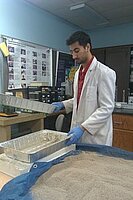Role of Agricultural Drainage on Transport of Cryptosporidium oocysts in North Dakota

Tanush Wadhawan was born in New Delhi, India. I have a diverse educational background, Bachelor of Science (B.S.) in Biotechnology (2008) and Master of Science (M.S.) in Environmental and Conservation Science (2010) from North Dakota State University (NDSU). I have worked with viability and biomass quantification of naturally and artificially immobilized bacteria. Currently, I am pursuing Ph.D in Civil Engineering at NDSU with an emphasis on Environmental Engineering. My project deals with understanding transport of Cryptosporidium oocysts in agricultural drainage system.
E-mail: Tanush.Wadhawan@ndsu.edu
Phone: 701-541-9978
Fellow: Tanush Wadhawan, Civil Engineering Department, NDSU
Advisor: Eakalak Khan, Ph.D., Professor and Department Chair, Department of Civil Engineering, North Dakota State University.
Matching Support: NDSU
Degree Progress: Ph.D.in Civil Engineering expected graduation in fall 2013.
Role of Agricultural Drainage on Transport of Cryptosporidium oocysts in North Dakota
Cryptosporidium is an infective protozoan which is one of the most important contaminants found in drinking water and is known to cause a parasitic gastrointestinal disease called cryptosporidiosis. Several outbreaks of cryptosporidiosis due to both groundwater and surface water contamination have been reported in North America. The use of manure for farm applications can be a major source of Cryptosporidium in the environment. Cryptosporidium in manure can infiltrate through soil and reach groundwater. Recent findings suggest Cryptosporidium in surface water comes from the overland runoff from the field. In this project, we propose an alternative route for Cryptosporidium contamination in surface water. Subsurface drain tiles are a network of subsurface drains that are used to enhance the drainage of agricultural land. We suspect these drains play a significant role in facilitating the transfer of Cryptosporidium from land to surface waters.
Project Objectives:
The main scope of the previous proposal (last year) was to investigate the role of agricultural drainage system on transport of Cryptosporidium in North Dakota. The specific objectives of the proposed study were as follows:
- To investigate adsorption and desorption of Cryptosporidium parvum on the soils obtained from agricultural fields in North Dakota.
- To determine the effects of agricultural drainage systems on the transport of Cryptosporidium parvum through the soils obtained from agricultural fields in North Dakota by simulating subsurface tile drains in a soil box.
- To study the transport of Cryptosporidium found in the manure applied to a subsurface drained agricultural field in North Dakota.
- During the course of the study, we observed that there is no literature on understanding the role of spring thaw in transporting Cryptosporidium. Here, we propose additional work that will investigate the transport of oocysts in the river sediments during winter and spring seasons.
The main scope of this year project is to investigate the role of spring thawing on transport of Cryptosporidium in North Dakota. The specific objectives of this study are as follows:
- To determine the prevalence of Cryptosporidium in the sediments of Red River of the North at Fargo, North Dakota before winter (before its freezes) and after spring thaw.
- To investigate settling and resuspension of oocysts in river sediments.
Progress:
Clayey soils and manure applied soil drastically increased the adsorption of Cryptosporidium. In addition, bench scale experiments were performed to understand the transportation of oocycts in subsurface drains during snowmelt and rain fall conditions. Higher transport of oocysts was observed during a snowmelt event compared to a rain fall event. There is work from the previous proposal that needs to be completed including analysis of samples collected from a field-scale drainage system (Discovery Farm, ND) and Cryptosporidium transport modeling.
Significance:
From the previous proposal the results generated are useful for understanding the transport of cryptosporidium under different groundwater regimes and different precipitation conditions. This information can be used by researchers and practitioners in understanding transport of Cryptosporidium. The new proposed research will demonstrate for the first time the impact of spring thawing on the transport of Cryptosporidium. It will greatly benefit North Dakota in identifying a possible source of cryptosporidiosis outbreaks in North Dakota and will benefit public health. The outcome of this project will be presented at a national or regional conference and will be submitted for publication in a peer reviewed journal. A final report containing all the information on the project including raw data will be delivered at the end of the project.
Conference:
Wadhawan, T., Kasi, M., McEvoy, J., Chu, M., Khan, E. 2012. Investigating transport of Cryptosporidium under snowmelt conditions. World Environmental and Water Resources Congress. Albuquerque, New Mexico, USA.
Wadhawan, T., Kasi, M., Chu, M., Khan, E., McEvoy, J. 2012. Bench-scale rainfall and snowfall simulations to understand Cryptosporidium parvum transport in subsurface groundwater regimes. IV International Giardia and Cryptosporidium Conference, Wellington, New Zealand.
Wadhawan, T., Kasi, M., McEvoy, J., Chu, M., Khan, E. 2011. Role of Manure Application on Soil in Preventing Groundwater Contamination by Cryptosporidium. 84rd Water Environment Federation's Annual Technical Exhibition and Conference, Los Angeles, USA.
Wadhawan, T., Khan, E., Chu, X., McEvoy, J. 2011. Adsorption of Cryptosporidium parvum oocyst on soil samples obtained from North Dakota. 2011 Land Grant & Sea Grant National Water Conference, Washington DC, USA.

Eakalak Khan
Civil & Environmental Engineering
NDSU

John McEvoy
AES Microbiological Sciences
Office: VanEs 132A
Telephone: 701-231-8530
Email: john.mcevoy@ndsu.edu


